Although beauty is in the eye of the beholder, there is more to pigs than meets the eye! They are, in fact, fascinating animals, ranging in size from the tiny pygmy hog to the enormous Eurasian wild pig. The world of pigs extends well beyond the domestic species frequently seen on farms. Hundreds of distinct types of pigs on Earth don’t have much in common except their unmistakable round and upturned snouts. Each species has a unique appearance, mannerisms, and geographic range, but they all share the same qualities of power, resourcefulness, and intelligence. However, despite their seemingly large population, a handful of pig species have gone extinct. So which ones are they?
The pig, one of the earliest animals humans domesticated, is widespread throughout the world, except for Antarctica, North Africa, and far northern Eurasia. These highly intelligent and gregarious beings are among the most common big mammals in the world and share many biological similarities with humans. In the United States alone, almost sixty million domestic pigs are on farms, and more than one billion are killed yearly for human consumption. While certain pig species are listed as being in varying risk states, others are extinct. This article will uncover 9 extinct pig species and other interesting facts.
9 Extinct Types of Pigs
1. Cumberland Pig

Yorkshire pigs are one of the Cumberland’s closest living relatives.
©Budimir Jevtic/Shutterstock.com
Originally from the North of England, the Cumberland breed of domestic pig was used to produce local specialties like Cumberland sausage and Cumberland ham. The breed went extinct around 1960 due to shifting farming practices and consumer preferences for less fatty meat.
The Cumberland pig was closely related to the Old Yorkshire White Pig, and it was a very old breed that most likely evolved over several hundred years in Cumberland and Westmorland. The Cumberland was a large, white animal with pendulous ears that could resist the harsh cold of Northern England thanks to its hardy nature. The breed had a high-fat content and quickly expanded to an above-average size.
2. Dorset Gold Tip
The Dorset Gold Tip was a breed of pig that originated in the United Kingdom and is now driven to extinction.
The Berkshire and possibly some additional Gloucester Old Spot ancestors were likely present in the Tamworth cross that gave rise to the Dorset Gold Tip. The breed was distinguished by its somewhat lopped (folded) ears, a coat with black patches and reddish base color, similar to the Tamworth, and gold-tipped hairs that gave the breed its name. The Gold Tip was bred for rapid growth, early maturity, and extreme size at a time when fat bacon was more coveted than it is now; some individuals were so big they could not move out of their enclosures.
3. Grice
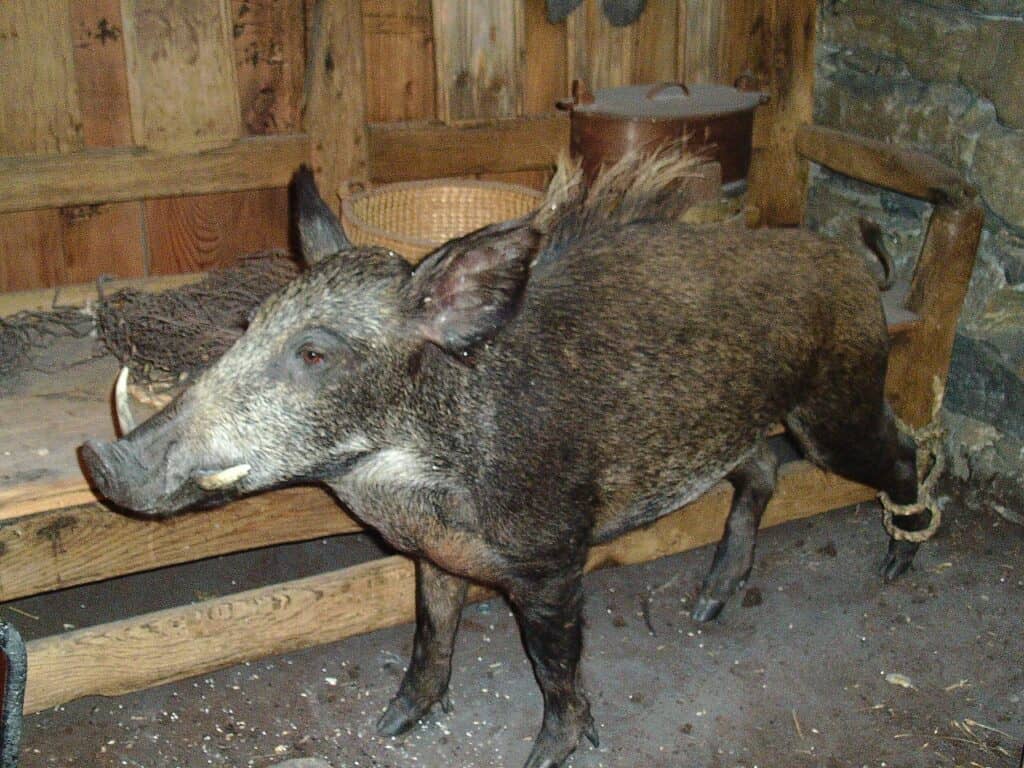
The grice was a small, sturdy animal that could withstand the tough weather conditions.
©Northerner / CC BY-SA 4.0 – License
The Islands of Scotland, Ireland, and the Highlands were home to the grice breed of swine. It went extinct, with the Shetland Isles being the place where it perished, between the middle of the 19th century and the 1930s.
Early 19th-century accounts paint a picture of the grice as a hostile creature with short tusks, an arched back, and a coat of rigid, dark bristles covering a wiry, woolly fleece. Highland examples were described as small, slender creatures with bristles that rose from their noses to their tails. The grice was a small, sturdy animal that could withstand the tough weather conditions, similar to other livestock in these regions.
4. Irish Greyhound Pig
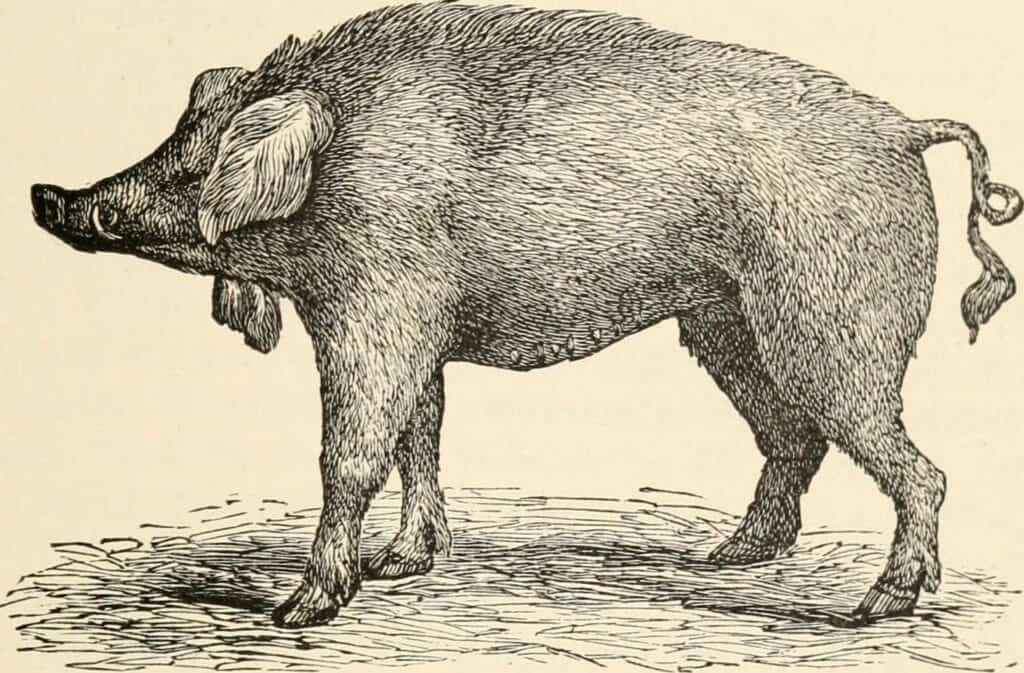
Irish Greyhound pigs had thick, coarse bone, rough bristles, long noses, and hanging ears.
©Internet Archive Book Images / CC0 1.0 – License
Until the 18th and 19th centuries, Irish Greyhound pigs were the standard in Ireland, and they continued to be domesticated at the turn of the 20th century. They were allegedly described in a rather unkind way as a very rough breed of animals, color white, standing extremely high on the legs, with narrow carcasses, thick, coarse bone, rough bristles, long noses, and hanging ears. They have also been characterized as maturing relatively slowly. It has been suggested that the pessimistic tone in descriptions of the pigs may be related to the challenges that poor farmers experienced in providing enough food for their pigs.
According to Savage (1964), these pigs may have originated from the wild boar rather than from the stock of other British domestic pigs. As per the accounts, the National Museum of Ireland in Dublin is home to the remains of the last Greyhound pigs, whose carcasses were last recorded in County Galway around 1900.
5. Large White Ulster Pig
The Large White Ulster, sometimes known as the Ulster White, was a domestic pig. It was the preferred breed of farmers in the north of Ireland until the middle of the 20th century as it was primarily developed for bacon production. The last registered boar was in 1956, and the breed has been extinct since 1960.
Whatever its precise ancestry, the Ulster White bred was a medium-sized pig that was long and quite deep in the body, with distinctly pendulous ears (like the Old Irish pig), and had white and rather thin skin. Compared to England’s equivalent Large White pig, it had finer bones, less hair, and shorter legs. It was well-liked by farmers due to its abundance, docility, and ease of care, and the sows made good mothers.
6. Lincolnshire Curly Coat
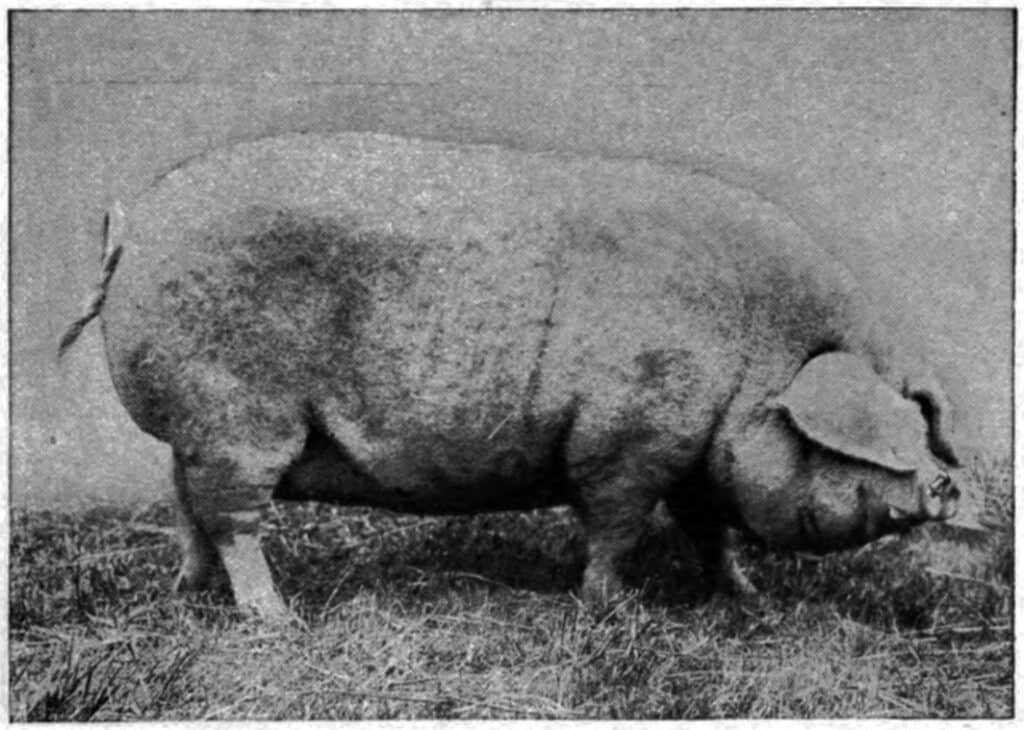
The Lincolnshire Curly Coat was a big pig with lop ears, but its most distinguishing characteristic was a long, curly white coat.
©public domain – License
The Baston Pig is another name for the extinct British breed of domestic pig known as the Lincolnshire Curly Coat or Lincolnshire Curly-coated. It was developed in and named after the East Midlands county of Lincolnshire. It became rare after the Second World War, along with many other traditional pig breeds; 1970 saw its extinction. The Hungarian Mangalica is an older, still-existing breed of pig with a similar appearance.
The Lincolnshire Curly Coat was intended to be strong and hardy, suited for smallholders, like other traditional “local” breeds in the United Kingdom. It was a big pig with lop ears, but its most distinguishing characteristic was a long, curly white coat that protected it from the chilly, wet winters in the fens of Lincolnshire.
7. Small Black Pig
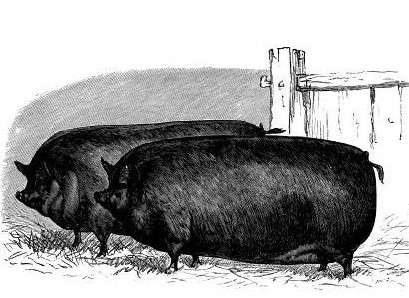
Except for color, it has been said that the Small Black pig closely resembled the Small White, a breed that originated in Yorkshire.
©Sanders Spencer / public domain – License
During the nineteenth century, the United Kingdom gave rise to the Small Black or Suffolk pig, a type of domestic pig that is now extinct. Uncertainty surrounds the breed’s origins; however, it is believed to have been developed by crosses between the Essex pig and other foreign breeds to “improve” it. Except for color, it has been said that the Small Black closely resembled the Small White, a breed that originated in Yorkshire. Like the Small White, the Small Black’s pinched ears, small size, and short upturned nose suggested an influence on the breed from imported Chinese pigs.
Agriculturists appear to have had a mixed opinion on the Small Black. Although the breed matured early, it quickly lost popularity at the turn of the 20th century due to claims that it had “a sensitive constitution” and “an excessively large amount of fat.”
8. Small White Pig
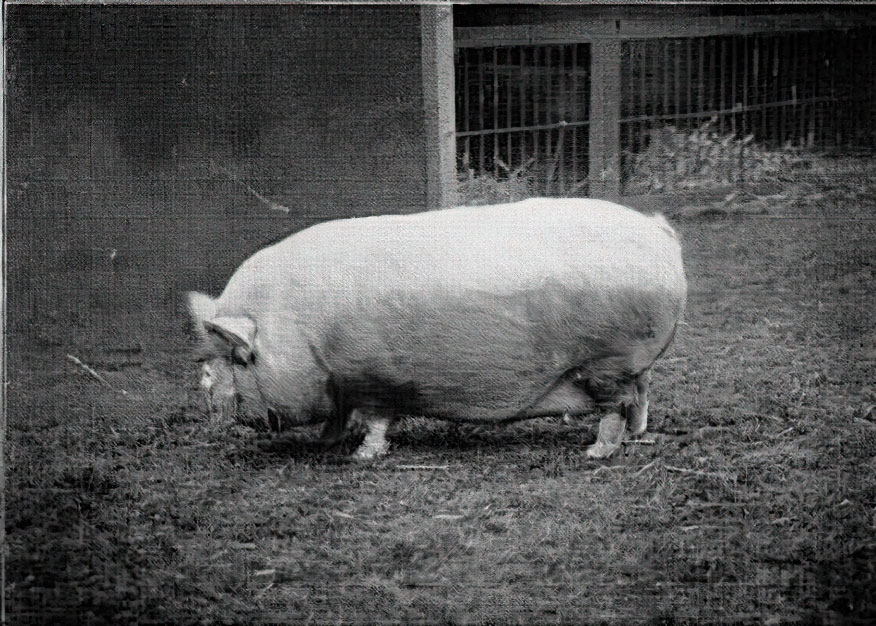
The Small White pig was always meant to be a show pig.
©Sanders Spencer / public domain – License
During the nineteenth century, the Small White or Small Yorkshire was a popular domestic pig breed in Britain. Although it is now extinct, the Middle White and other breeds were created using its traits. The Middle White gained popularity, which caused the Small White species to dwindle and had almost completely vanished by the turn of the century. They eventually went extinct in 1912.
Early in the nineteenth century, the traditional Old Yorkshire, a large white pig, was crossed with imported Chinese pigs to create the Small White. The result was a little creature with a primary color of pure white, pricked ears, a short, wide head, and the Chinese breeds’ distinctively short, upturned nose. Like the Chinese breeds, they matured early and put on fat quickly. The Small White was never meant to be a bacon or porker pig; it was always meant to be a show pig. In contrast to farmers or smallholders, it was particularly popular with aristocratic and “hobby” breeders.
9. Yorkshire Blue and White
A domestic pig breed known as the Yorkshire Blue and White, often referred to as the Bilsdale Blue or the “Blood Breed,” originated in the United Kingdom and is now thought to be extinct. Three licensed boars existed in 1954 and one in 1963. Before 1973, the breed seemed to have gone extinct.
The North Riding of Yorkshire gave way to the Blue and White, a small breed of pig that shared some traits with the Large White pig that also originated there. The large blue dots on the skin that had been gradually bred out of other white pigs were retained, as its name implied. Small farmers continued to favor the Blue and White because of their hardiness and the sows’ superior maternal skills until the middle of the 20th century. On the other hand, it was rare nationally and barely known outside North Riding.
Summary of 9 Types of Extinct Pigs
| Pig Species | Characteristics | Extinction Date |
|---|---|---|
| Cumberland | Large, white pig with above-average fat content. | c. 1960 |
| Dorset Gold Tip | Very large, with folded ears and a reddish coat with black spots and gold-tipped fur. | 1960s or 1970s |
| Grice | Small, sturdy pig with short tusks and a wiry coat; known for its aggressive nature. | Between the mid-19th century and the 1930s. |
| Irish Greyhound | White, tall, and slender, with a bristly coat and a long nose. | c. 1900 |
| Large White Ulster | Medium-sized pig known for its docile nature and easy care requirements. Used for bacon. | 1960 |
| Lincolnshire Curly Coat | Strong and sturdy pig with a long, curly white coat. | 1970 |
| Small Black | Small pig with a reportedly “sensitive constitution” and high amounts of fat. | 20th century. |
| Small White | Small pig with a short, upturned nose. Bred to be a show pig for the aristocracy. | 1912 |
| Yorkshire Blue and White | Hardy pig with a white coat that sported blue dots. | Before 1973. |
The photo featured at the top of this post is © Internet Archive Book Images / CC0 1.0 – License / Original
Thank you for reading! Have some feedback for us? Contact the AZ Animals editorial team.







